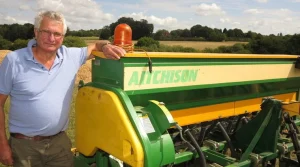Weeds are unwanted plants that compete with cultivated crops for essential resources such as nutrients, water, and sunlight. They can significantly reduce crop yields, posing a challenge to agricultural productivity.
Weeds come in various types, broadly categorized into two groups:
- Broadleaf Weeds: Examples include dandelion, clover, and thistle. They have wide leaves and often bear colorful flowers.
- Grass Weeds: Examples include crabgrass, quackgrass, and annual bluegrass. They have narrow leaves and can be particularly invasive.
Table of Contents
Toggle10 common weed names
-
Dandelion (Taraxacum officinale):
- Broadleaf weed with distinctive yellow flowers and toothed leaves. Known for its deep taproot, making it resilient and challenging to remove.
-
Crabgrass (Digitaria spp.):
- Grass weed with spreading stems and wide, flat blades. Commonly found in lawns and gardens, it can quickly colonize open spaces.
-
Thistle (Cirsium spp.):
- Broadleaf weed with spiky leaves and distinctive purple or pink flowers. Some varieties have sharp spines on the leaves, making them prickly.
-
Quackgrass (Elymus repens):
- Grass weed with creeping rhizomes. Identified by its long, flat leaves and a characteristic membranous ligule where the leaf joins the stem.
-
Chickweed (Stellaria media):
- Low-growing broadleaf weed with small, paired leaves. Often found in moist conditions and known for its rapid spreading through seeds.
-
Bindweed (Convolvulus arvensis):
- Vining weed with heart-shaped leaves and trumpet-shaped white or pink flowers. Known for its aggressive growth and ability to twine around other plants.
-
Bermuda Grass (Cynodon dactylon):
- Grass weed with fine-textured blades and spreading stolons. It forms dense mats and is resilient in various environments, making it a common lawn invader.
-
Broadleaf Plantain (Plantago major):
- Broadleaf weed with oval-shaped leaves and distinctive parallel veins. Often found in compacted soils and known for its resistance to trampling.
-
Common Purslane (Portulaca oleracea):
- Low-growing succulent broadleaf weed with fleshy leaves. Recognized by its prostrate growth habit and small yellow flowers.
-
Yellow Nutsedge (Cyperus esculentus):
- Sedge weed with triangular stems and grass-like leaves. Identified by its yellowish-brown flower spikes and an extensive system of underground tubers.
Methods to Remove Weeds
1. Manual Weeding:
- Description: Involves physically removing weeds by hand or using tools such as hoes or sickles.
- Pros: Effective for small-scale operations.
- Cons: Labor-intensive and time-consuming, not practical for large-scale farming.
2. Chemical Weed Control:
- Description: Involves the use of herbicides to kill or inhibit weed growth.
- Pros: Can be effective for widespread weed control.
- Cons: Requires careful handling, and may pose environmental and health risks.
3. Mechanical Weed Control with Seed Drill:
- Description: Utilizes a seed drill, an agricultural tool designed for planting seeds, equipped with additional features for weed control.
- Pros: Efficient for large-scale farming, simultaneous sowing of seeds, and weed removal.
- Cons: Initial investment in the seed drill equipment.
Weed Removal with Seed Drill: Tools and Techniques
1. Seed Drill Attachment – Tine Weeder:
- Description: A specific attachment designed for seed drills.
- Function: Equipped with sharp tines that penetrate the soil between crop rows, mechanically uprooting emerging weeds.
- Versatility: Capable of uprooting both grass and broadleaf weeds, making it a versatile tool for weed control.
2. Adjustable Depth and Spacing:
- Function: The seed drill can be adjusted to different depths, allowing farmers to target specific weed species and minimize damage to the crop.
- Importance: Proper adjustment ensures effective weed removal without compromising crop health.
3. Preparation of Soil:
- Step: Tilling the soil before sowing to break it up and remove existing weeds or weed seeds.
- Importance: Prepares a clean seedbed, reducing competition from weeds.
4. Consistent Speed Operation:
- Recommendation: Operate the seed drill at a consistent speed.
- Importance: Ensures even seed distribution and uniform planting, reducing the potential for weed infestation.
5. Regular Monitoring:
- Practice: Regularly monitor the crop field.
- Importance: Promptly identify and address emerging weeds to prevent competition with crops.
Conclusion
In conclusion, weed removal is a critical aspect of successful crop cultivation. Utilizing a seed drill, especially with a tine weeder attachment, streamlines the process by efficiently uprooting emerging weeds while sowing crop seeds. By employing proper techniques and tools, farmers can manage weed growth effectively, leading to better crop yields. The investment in a seed drill pays off in terms of time saved and increased agricultural productivity.
Frequently Asked Questions (FAQs) – Weed Removal by Seed Drill
Q1: What is a seed drill?
A: A seed drill is an agricultural tool designed for efficiently planting seeds in rows at a uniform depth and spacing. It is commonly used in large-scale farming operations to streamline the planting process.
Q2: Why is weed removal important in agriculture?
A: Weeds compete with cultivated crops for essential resources such as nutrients, water, and sunlight. Effective weed removal is crucial to ensure optimal crop growth, prevent yield reduction, and enhance agricultural productivity.
Q3: What are the different types of weeds?
A: Weeds can be broadly categorized into two groups: broadleaf weeds (e.g., dandelion, clover) with wide leaves and grass weeds (e.g., crabgrass, quackgrass) with narrow leaves.
Q4: How do seed drills contribute to weed removal?
A: Seed drills equipped with specific attachments, such as tine weeders, play a dual role. They efficiently sow seeds while simultaneously uprooting emerging weeds, offering a streamlined solution for weed control in large farming operations.
Q5: What is a tine weeder attachment?
A: A tine weeder is a seed drill attachment with sharp tines designed to penetrate the soil between crop rows. It mechanically uproots emerging weeds, providing versatility by targeting both grass and broadleaf weeds.
Q6: Can a seed drill be adjusted for different weed species?
A: Yes, seed drills are designed to be adjustable. Farmers can customize the depth and spacing settings to target specific weed species, minimizing damage to the crop while effectively removing weeds.
Q7: What steps should be followed for efficient weed removal with a seed drill?
A: Key steps include setting the seed drill to the appropriate depth and spacing, proper soil preparation through tilling, consistent speed operation for even seed distribution, and regular monitoring of the crop field to promptly address emerging weeds.
Q8: Is using a seed drill for weed removal cost-effective?
A: While there is an initial investment in seed drill equipment, the efficiency gained in weed removal, time saved, and increased agricultural productivity often make it a cost-effective choice for large-scale farming operations.
Q9: Can seed drills be used for organic farming?
A: Yes, seed drills can be used in organic farming. Farmers can choose organic seeds and employ organic weed control methods while utilizing seed drills for efficient planting and weed removal.




